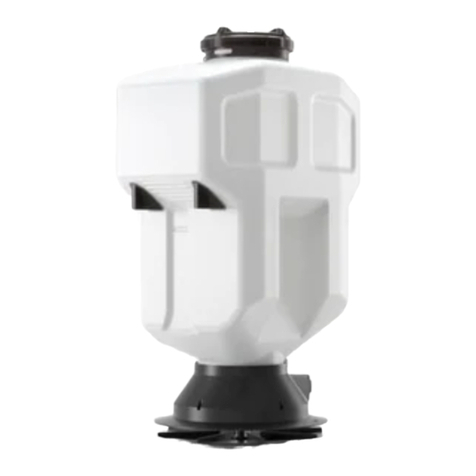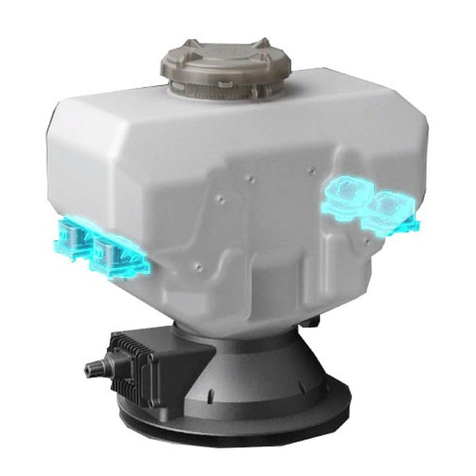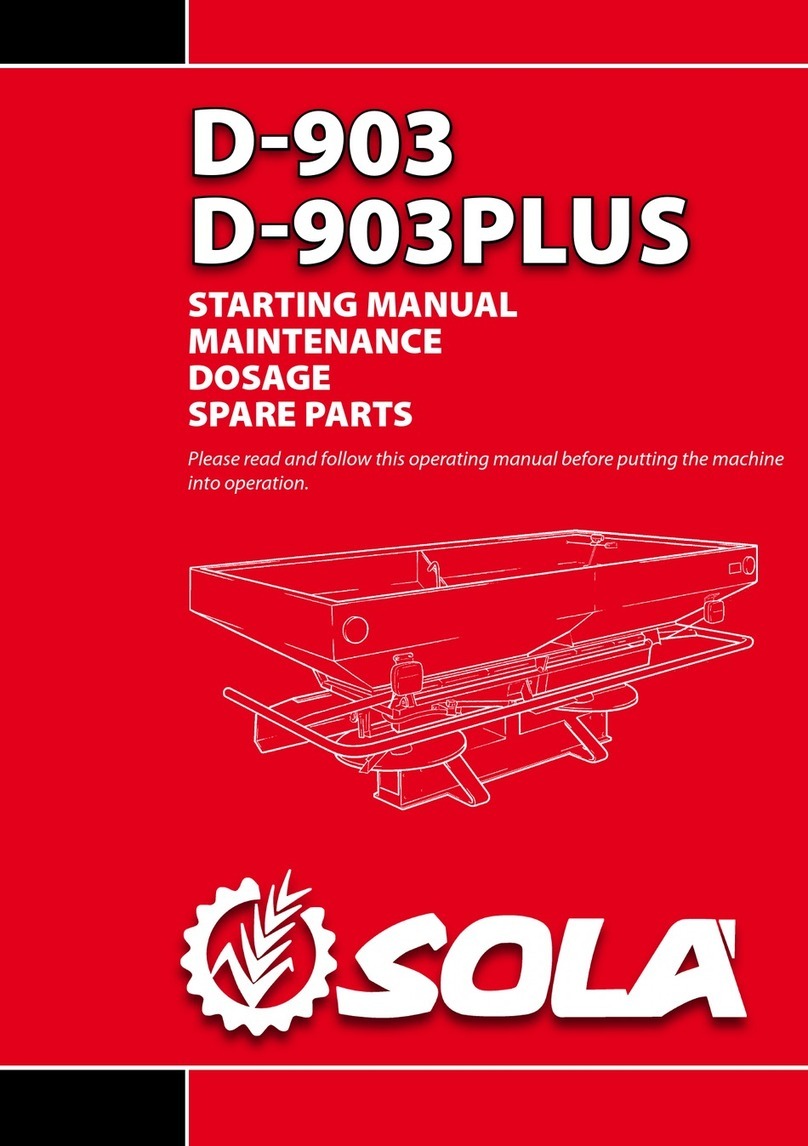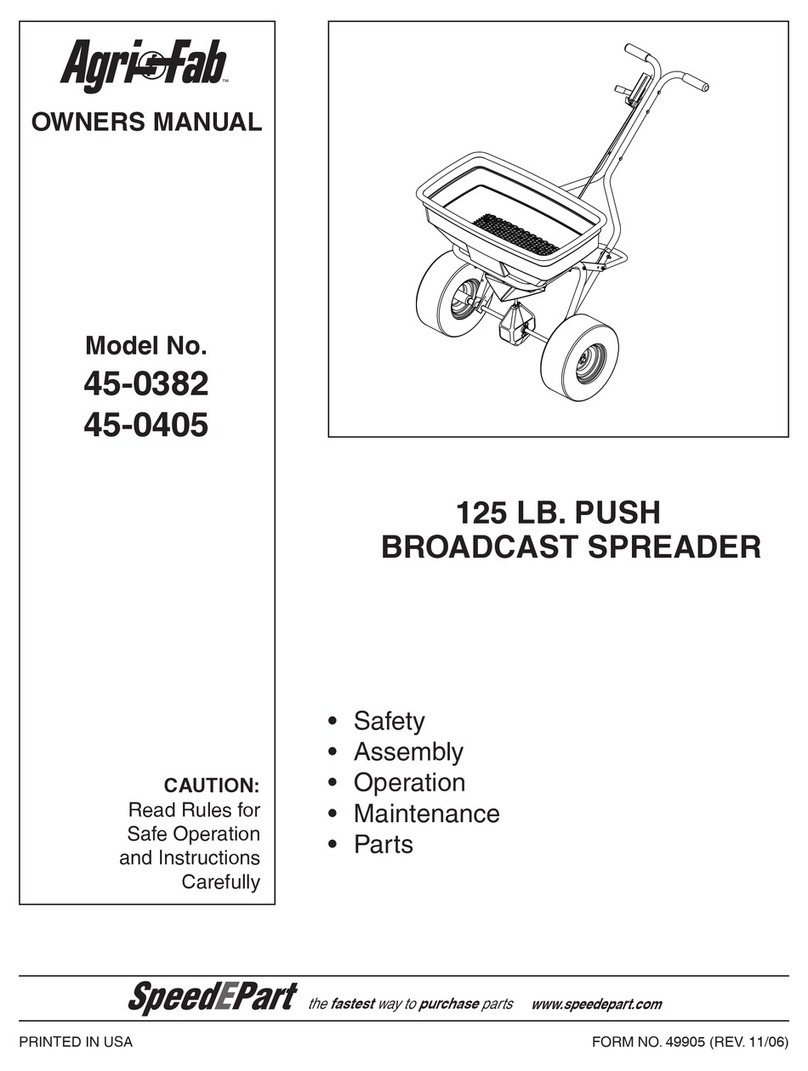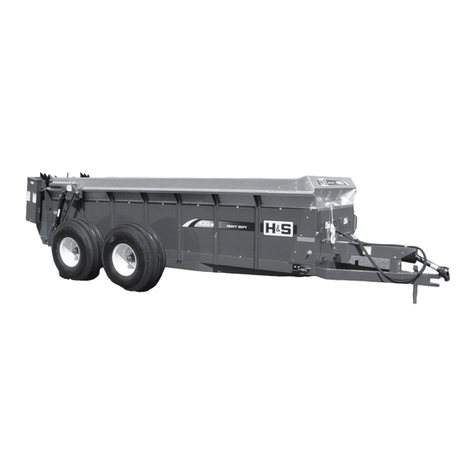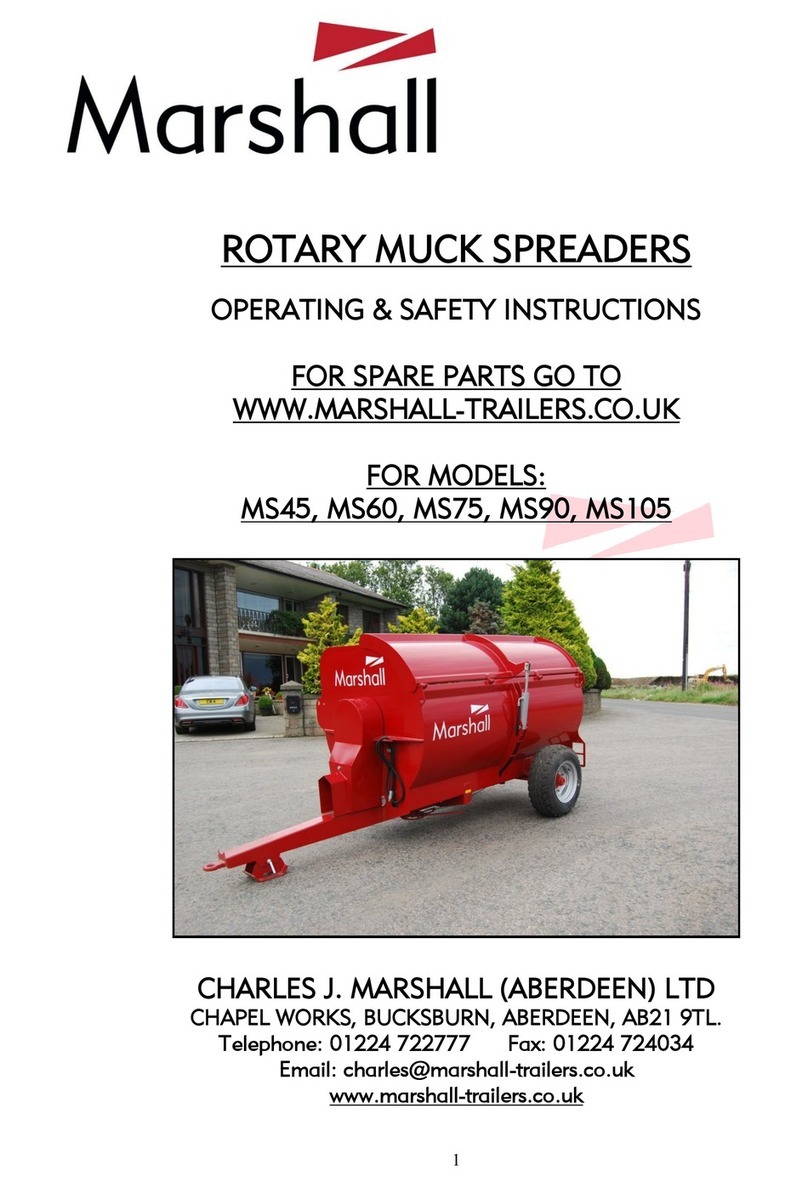dji T20 User manual

Quick Start Guide
快速入門指南
빠른 시작 가이드
Hướng dẫn nhanh
Schnellstartanleitung
Guía de inicio rápido
Guide de démarrage rapide
Guia rápido
AGRAS T20
v1.0

2
EN
EN
Aircraft
The AGRASTM T20 features a brand-new design including a foldable frame and a quick-release spray tank and flight battery,
making replacement, installation, and storage easy. The stable and reliable modular aerial-electronics system is integrated
with a dedicated industrial flight controller, OCUSYNCTM 2.0 HD transmission system, and RTK module. It has dual IMUs and
barometers and adopts a propulsion control system redundancy design including both digital and analog signals to ensure
flight safety.
The GNSS+RTK dual-redundancy system is compatible with GPS, GLONASS, BeiDou, and Galileo. The T20 also supports
centimeter-level positioning* when used with the onboard D-RTKTM. Dual-antenna technology provides strong resistance
against magnetic interference. The upgraded spraying system features an improvement in payload. It also has a 4-channel
electromagnetic flow meter to ensure consistent spraying for all sprinklers. The new-generation omnidirectional digital radar
provides functions such as terrain following and obstacle sensing and circumventing in all horizontal directions. The aircraft
is equipped with a wide-angle FPV camera that enables users to observe the landscape from the front of the aircraft.
Due to its industrial design and material, the T20 is dustproof, waterproof, and corrosion-resistant. The aircraft has a
protection rating of IPX6 (IEC standard 60529), while the protection rating of the aerial-electronics system, spray control
system, propulsion ESC system, and radar module is up to IP67.
1. Propellers
2. Motors
3. ESCs
4. Frame Arms
5. Aircraft Front Indicators (on the
three front arms)
6. Hoses
7. Sprinklers
8. Electromagnetic Exhaust
Valves
9. Nozzles
10. Aerial-Electronics System
11. FPV Camera
12. USB-C Port (on the bottom of the
aerial-electronics system, under
the waterproof cover)
13. 4-Channel Electromagnetic Flow
Meter
14. Delivery Pumps
15. Omnidirectional Digital Radar
16. Landing Gear
17. Spray Tank
18. Battery Compartment
19. OcuSync Antennas
20. Onboard D-RTK Antennas
21. Aircraft Status Indicators (on
the three rear arms)
22. Remote Controller Holder
* Must be used with a DJI D-RTK 2 High Precision GNSS Mobile Station (sold separately) or a DJI-approved Network RTK service.
FoldedRight ViewBottom View
Aircraft Front
4
610
2
3
5
1
20
11
15
16
19
17
14
18
21
12
13
22
9
8
7

3
EN
EN
Remote Controller
The Smart Controller 2.0 uses the DJITM OcuSync 2.0 transmission system, has a maximum control distance of up to 5 km*,
and supports Wi-Fi and Bluetooth functions. The remote controller is equipped with a 5.5-inch bright, dedicated screen that has
the DJI Agras app built in, significantly improving smoothness and stability. When the RTK dongle is connected to the remote
controller, users can plan operations to centimeter-level precision. The Multi-Aircraft Control mode* of the remote controller can be
used to coordinate the operation of up to three aircraft at the same time, enabling pilots to work efficiently. Both the built-in battery
and external battery can be used to supply power to the remote controller. The total working time is up to 4 hours, which fully
meets the requirements for long and high-intensity operations.
The figure below shows the function that each control stick movement performs, using Mode 2 as an example. In Mode 2,
the left stick controls the aircraft’s altitude and heading, while the right stick controls its forward, backward, and left and
right movements.
* The remote controller is able to reach its maximum transmission distance (FCC / NCC: 5 km (3.11 mi); CE / KCC / MIC / SRRC:
3 km (1.86 mi)) in an open area with no electromagnetic interference, and at an altitude of approximately 2.5 m (8.2 ft).
Make sure to comply with local laws and regulations when using Multi-Aircraft Control mode.
1. Antennas
2. Back Button / Function Button
3. Control Sticks
4. RTH Button
5. Button C3 (customizable)
6. Flight Mode Switch
7. Status LED
8. Battery Level LEDs
9. 5D Button (customizable)
10. Power Button
11. Confirm Button
12. Touch Screen
13. USB-C Charging Port
14. Dongle Compartment Cover
15. Spray Rate Dial
16. Spray Button
17. HDMI Port
18. microSD Card Slot
19. USB-A Port
20. FPV / Map Switch Button
21. Work Efficiency Dial
22. Air Outlet
23. Button C1 (customizable)
24. Button C2 (customizable)
25. Battery Cover
26. Battery Cover Release Button
27. Handle
Left Stick Right Stick
Up
Down
Turn Left Turn Right
Forward
Backward
Left Right
22
24
27
25
26
23
15
16
17 18 19
20
21
17
23
569
10
12
14
11
8
13
4

4
EN
EN
Flying Considerations
1. DO NOT use the aircraft to spray in winds exceeding 18 kph (11 mph).
2. DO NOT use the aircraft in adverse weather conditions such as winds exceeding 28 kph (17 mph), heavy rain (precipitation rate
exceeding 25 mm (0.98 in) in 12 hours), snow, or fog.
3. The recommended maximum operating altitude is 2 km (6,560 ft) above sea level. DO NOT fly over 3 km (9,842 ft) above sea
level.
4. Once the operating altitude reaches 1 km (3,280 ft), the payload capacity of the spray tank is reduced by 2 kg. For every
additional km, the payload capacity will reduce by a further 2 kg.
5. Make sure that there is a strong GNSS signal and the D-RTK antennas are unobstructed during operation.
Return to Home (RTH)
The aircraft will automatically return to the Home Point in the following situations:
Smart RTH: You press the RTH button.
Failsafe RTH: The remote controller signal is lost.*
If there is an obstacle within 20 m of the aircraft, the aircraft decelerates and then stops and hovers. If the aircraft comes within 6
m of the obstacle while decelerating, the aircraft stops, flies backward to a distance of approximately 6 m from the obstacle, and
hovers. The aircraft exits the RTH procedure and waits for further commands.
Fly Safe
It is important to understand some basic flight guidelines, both for your protection and for the safety of those around you.
1. Flying in Open Areas: Pay attention to utility poles, power lines, and other obstacles. DO NOT fly near or above water, people,
or animals.
2. Maintain Control at All Times: Keep your hands on the remote controller and maintain control of your aircraft when it is in flight,
even when using intelligent functions such as the Route and A-B Route operation modes and Smart Return to Home.
3. Maintain Line of Sight: Maintain visual line of sight (VLOS) with your aircraft at all times and avoid flying behind buildings or other
obstacles that may block your view.
4. Monitor Your Altitude: For the safety of manned aircraft and other air traffic, fly at altitudes lower than 30 m (98 ft) and in
accordance with all local laws and regulations.
Visit https://www.dji.com/flysafe for more information on critical safety features such as GEO zones.
≥ 6 m
RTH
Pesticide Usage
1. Avoid the use of powder pesticides as much as possible as they may reduce the service life of the spraying system.
2. Pesticides are poisonous and pose serious risks to safety. Only use them in strict accordance with their specifications.
3. Use clean water to mix the pesticide and filter the mixed liquid before pouring into the spray tank to avoid blocking the strainer.
4. Effective use of pesticides depends on pesticide density, spray rate, spray distance, aircraft speed, wind speed, and wind
direction. Consider all factors when using pesticides.
5. DO NOT compromise the safety of people, animals, or the environment during operation.
It is important to understand some basic flight guidelines, both for your protection and for the safety of those around you.
Make sure to read the disclaimer and safety guidelines.
* If Failsafe RTH is disabled (the default setting in the DJI Agras app), the aircraft hovers in place when the remote controller signal
is lost.
●Obstacle avoidance is disabled in Attitude mode (which the aircraft enters in situations such as when the GNSS signal
is weak) and is not available if the operating environment is not suitable for the radar module. Extra caution is required in
such situations.

5
EN
EN
1. Preparing the Intelligent Flight Battery
2. Preparing the Aircraft
●Make sure that the battery is firmly inserted into the aircraft. Only insert or remove the battery when the aircraft is
powered off.
●To remove the battery, press and hold the clamp, and then lift the battery up.
●When folding the arms, make sure to fold the M3 and M5 arms first, and then the M2 and M6 arms. Otherwise, the
arms may be damaged. Lift and lower the M1 and M4 arms gently to reduce wear and tear.
Unfold the M2 and M6 arms, and tighten
the two arm sleeves.
Unfold the M3 and M5 arms followed by M1 and
M4, and then tighten the four arm sleeves.
Unfold the propeller blades. Insert the Intelligent Flight Battery into the aircraft
until you hear a click.
Only use official DJI flight batteries (model: AB3-18000mAh-51.8V).
Check the battery level before flying, and charge it according to the
corresponding document.
M2 M6
M3
M4
M1
M5
Using the T20

6
EN
EN
●To remove the Intelligent Battery, press and hold the battery release button, then push the battery downward.
●Only use a DJI-approved dongle. The dongle supports various network standards. Use a SIM card that is compatible
with the chosen mobile network provider, and select a mobile data plan according to the planned level of usage.
●The dongle and SIM card enable the remote controller to access specific networks and platforms, such as the DJI
AG platform. Make sure to employ them correctly. Otherwise, network access will not be available.
Mounting the 4G Dongle and SIM Card
Mounting the External Battery
1Press the battery cover release button on the back of
the remote controller to open the cover.
2Insert the Intelligent Battery into the compartment and
push it to the top.
3Close the cover.
Remove the dongle compartment cover.
Insert the dongle into the USB port with the SIM card inserted into the dongle,
and test the dongle.*
Dongle
Reattach the cover firmly.
* Test procedure: Press the remote controller power button once, then press again and hold to power the remote
controller on. In DJI Agras, tap , and select Network Diagnostics. The dongle and SIM card are functioning properly if
the status of all the devices in the network chain are shown in green.
3. Preparing the Remote Controller
Charging the Batteries
Charge the external Intelligent Battery using the charging hub and AC power adapter. Charge the internal battery of the remote
controller using the USB charger and USB-C cable. Fully charge the batteries before using for the first time.
AC Power Adapter
Charging Hub Power Outlet
(100 - 240 V)
Mounting the RTK Dongle
When using the RTK planning method to plan the operation area, attach the
RTK dongle to the USB-A port on the remote controller.
USB Charger
2
3
Battery Release Button

7
EN
EN
Optimal Transmission Zone
●When using for the first time, activate the aircraft using the DJI Agras app. Your DJI account and an internet connection
are required.
Checking the Battery Levels
Low High
Low
High
Press the power button on the remote controller once to check the internal battery level. Press once, then press again and
hold for two seconds to power on or off.
Press the battery level button on the external Intelligent Battery once to check the battery level.
Adjusting the Antennas
Lift the antennas and adjust them. The strength of the remote controller signal is
affected by the position of the antennas. When the angle between the antennas and
the back of the remote controller is 80° or 180°, the connection between the remote
controller and aircraft can reach its optimal performance.
4. Getting Ready for Takeoff
A. Place the aircraft on open, flat ground with the aircraft rear facing toward you.
B. Make sure that the propellers are securely mounted, there are no foreign objects in or on the motors and propellers, the
propeller blades and arms are unfolded, and the arm sleeves are
firmly tightened.
C. Make sure that the spray tank and flight battery are firmly in
place.
D. Pour liquid into the spray tank, and tighten the cover. Make sure
that the four lines on the cover are aligned to the horizontal or
vertical direction.
E. Power on the remote controller, make sure that the DJI Agras
app is open, and then power on the aircraft.
Internet
●Avoid using wireless devices that use the same frequency bands as the remote controller.
●If the RTK dongle is used for field planning, the module should be disconnected from the remote controller after
planning is completed. Otherwise, it will affect the communication performance of the remote controller.
●When using an external Intelligent Battery, it is still necessary to make sure that the internal battery has some
power. Otherwise, the remote controller cannot be powered on.
Try to keep the aircraft inside the optimal transmission zone. If the signal is weak, adjust the antennas or fly the aircraft closer.
80°

8
EN
EN
OR
Throttle Stick (left stick in Mode 2)
5. Flight
In the app, go to Operation View. Make sure that there is a strong GNSS signal, and the system status bar indicates Manual
Route (GNSS) or Manual Route (RTK).* Otherwise, the aircraft cannot take off.
It is recommended to create a plan for a field and select an operation to enable the aircraft to take off and perform the
operation automatically. Refer to the Starting Operations section for more information. In other cases, take off and land
manually.
Takeoff
Perform a Combination Stick Command (CSC) and push the throttle stick up to take off.
Landing
To land, pull down on the throttle stick to descend until the aircraft touches the ground. There are two methods to stop the
motors.
Method 1: When the aircraft has landed, push and hold the throttle stick down. The motors will stop after three seconds.
Method 2: When the aircraft has landed, push the throttle stick down, and perform the same CSC that was used to start the
motors. Release both sticks once the motors have stopped.
* RTK positioning is recommended. In the app, go to Operation View, tap , then RTK to enable Aircraft RTK, and select a
method for receiving RTK signals.
●DO NOT calibrate your compass where there is a chance of strong magnetic interference. This includes areas
where there are utility poles or walls with steel reinforcements.
●DO NOT carry ferromagnetic materials with you during calibration such as keys or mobile phones.
Calibrating the Compass
When the app prompts that compass calibration is required, tap , then , slide to the bottom, and select Advanced
Settings, then Sensors. Tap Calibration in the compass calibration section, then follow the on-screen instructions.
Discharging the Bubbles in the Hoses
The T20 features an automatic bubbles discharge function. When it is necessary to discharge bubbles, press and hold the
spray button for two seconds. The aircraft will discharge automatically until the bubbles are fully discharged.
Calibrating the Flow Meter
Make sure to calibrate the flow meter before your first operation. Otherwise, the spraying performance may be adversely
affected.
A. Preparation before calibration: Discharging the bubbles in the hoses
1Fill the spray tank with approximately 2 L of water.
2Use the automatic bubbles discharge function to discharge the bubbles according to the descriptions in the
Discharging the Bubbles in the Hoses section below. Users can also manually discharge the bubbles. Press the spray
button to spray the bubbles and press the button again once all bubbles are discharged.
B. Flow Meter Calibration
1In the app, tap Execute Operation to enter Operation View. Tap , then , and tap Calibration on the right of the
flow meter section.
2Calibration starts automatically. After 25 seconds, the result of the calibration is displayed in the app.
●After calibrating successfully, users can proceed with the operation.
●If calibration fails, tap “?” to view and resolve the problem. Afterward, recalibrate.

9
EN
EN
●Spinning propellers can be dangerous. Stay away from spinning propellers and motors. DO NOT start the motors in
confined spaces or when there are people nearby.
●Keep your hands on the remote controller when the motors are spinning.
●DO NOT stop the motors mid-flight unless in an emergency situation where doing so will reduce the risk of damage
or injury.
●Method 1 is the recommended method for stopping the motors. When using Method 2 to stop the motors, the
aircraft may roll over if it is not completely grounded. Use Method 2 with caution.
●After landing, power off the aircraft before turning off the remote controller.
Starting Operations
After the operation area and obstacles have been measured and settings have been configured, DJI Agras uses a built-in
intelligent operation planning system to produce a flight route based on the user’s input. Users can invoke an operation after
planning a field. The aircraft will begin the operation automatically and follow the planned flight route.
In scenarios with complicated terrain, users can use the Phantom 4 RTK and DJI TERRATM to plan 3D flight routes, and then
import the routes to the DJI Agras app for operation. Refer to the Agras T20 User Manual for more information.
Field Planning
The DJI Agras app supports flight route planning by flying the aircraft to waypoints, obstacles, and calibration points or by
walking to these points carrying a remote controller, a remote controller with an RTK dongle, or an RTK device. The following
route has been planned by walking to the points with a remote controller that has a RTK dongle connected. Before planning,
make sure that the RTK dongle is mounted to the remote controller.
* If any obstacles are in the
operation area.
●Calibration points are used to rectify flight route biases caused by positioning deviations. Choose one or more fixed
reference points for calibration like a metal peg or obvious marker that is easy to identify for bias rectification when
using the operation.
Method 1 Method 2
OR
Walk to each obstacle*
in turn and tap Obstacle
Mode C1.*
Walk around the obstacle and tap Add Obstacle C2 at
several points around the obstacle.*
Walk with the remote
controller alongside the
boundary of the operation
area and tap Add Waypoint
C2 at turning points.
Once you have finished planning, tap in the upper left
corner of the screen to return to the home screen.
Tap Waypoint Mode C1
to return to add edge
points to the operation
area.
The waypoints and flight route can be
edited. Fine-tune waypoint positions,
configure distance and line spacing, and
adjust the route direction by tapping or
dragging the icon.
Save the
field plan.
Walk to the location of
each calibration point and
tap Calibration Point.
Power on the remote
controller. Launch DJI
Agras.
Tap Plan Field,
select Walk with RTK, then
Walk with RTK Dongle.
DJI Agras
In RTK settings, select a method for receiving RTK
signals and configure corresponding settings. Make sure
the aircraft status bar on top of the screen is green.
RTK

10
EN
EN
Performing an Operation
6. Maintenance
Clean all parts of the aircraft and remote controller daily and immediately after spraying:
1. Fill the spray tank with clean water or soapy water and spray the water through the nozzles until the tank is empty. Repeat
the step two more times.
2. Detach the spray tank and spray tank connector to clean them. Remove the spray tank strainer, nozzle strainers, and nozzles
to clean them and clear any blockage. Afterwards, immerse them in clean water for 12 hours.
3. Use a water-filled spray washer to clean the aircraft body and wipe it with a soft brush or wet cloth before cleaning water
stains with a dry cloth.
4. If there is dust or pesticide liquid on the motors and propellers, wipe them with a wet cloth before cleaning water stains with a
dry cloth.
5. Wipe the surface and screen of the remote controller with a clean wet cloth that has been wrung out with water daily after
operations.
Refer to the disclaimer and safety guidelines for more information on product maintenance.
Refer to the Agras T20 User Manual for more information.
Operation Resumption
More Operation Modes
Refer to the Agras T20 User Manual for more information about the A-B Route, Manual, and Manual Plus Operation modes.
More Functions
System Data Protection Empty Tank
Tap Execute Operation
in the home screen of the
app.
Take the aircraft to one of
the calibration points.
Tap Edit to edit the waypoints
and flight route again.
Tap Invoke, and then
tap Rectify Offset.
Tap Start. Set the operation
parameters, then confirm.
Set the auto-takeoff height and
move the slider to take off. The
aircraft will perform the operation
automatically.
●Only take off in open areas and set an appropriate auto-takeoff height according to the operating environment.
●An operation can be paused by moving the control stick slightly. The aircraft will hover and record the breakpoint,
and then the aircraft can be controlled manually. To continue the operation, select it again from the Executing tag in
list, and the aircraft will return to the breakpoint automatically and resume the operation. Pay attention to aircraft
safety when returning to a breakpoint.
●In Route Operation mode, the aircraft is able to circumvent obstacles, which is disabled by default and can be
enabled in the app. If the function is enabled and the aircraft detects obstacles, the aircraft will slow down and
circumvent the obstacles, and then return to the original flight path.
●Users can set the action the aircraft will perform after the operation is completed in the app.
Tap , select the field
from the field list.

11
EN
EN
Specifications
●Product Model 3WWDZ-15.1B
●Airframe
Max Diagonal Wheelbase 1883 mm
Dimensions 2509×2213×732 mm (Arms and propellers unfolded)
1795×1510×732 mm (Arms unfolded and propellers folded)
1100×570×732 mm (Arms and propellers folded)
●Propulsion System
Motors
Stator Size 100×15 mm
KV 75 rpm/V
Max Thrust 13.5 kg/rotor
Max Power 2400 W/rotor
Weight 666 g
ESCs
Max Working Current
(Continuous)
40 A
Max Working Voltage 58.8 V (14S LiPo)
Foldable Propellers (R3390)
Diameter × Pitch 33×9 in
Weight (Single propeller) 90 g
●Spraying System
Spray Tank
Volume Full: 20 L
Operating Payload Full: 20 kg
Nozzles
Model XR11001VS (Standard); XR110015VS, XR11002VS (Optional, purchase separately)
Quantity 8
Max Spray Rate XR11001VS: 3.6 L/min, XR110015VS: 4.8 L/min, XR11002VS: 6 L/min
Spray Width 4 - 7 m (8 nozzles, at a height of 2 - 3 m above crops)
Droplet Size XR11001VS: 130 - 250 μm, XR110015VS: 170 - 265 μm, XR11002VS: 190 - 300 μm (Subject
to operating environment and spray rate)
Flow Meter
Measurement Range 0.25 - 20 L/min
Error < ±2%
Measurable Liquid Conductivity > 50 μS/cm (Liquids such as tap water or pesticides that contain water)
●Omnidirectional Digital Radar
Model RD2428R
Operating Frequency CE / FCC / NCC: 24.05 - 24.25 GHz
MIC / KCC: 24.05 - 24.25 GHz
Transmitter Power (EIRP) MIC / KCC / CE / FCC / NCC: < 20 dBm
Power Consumption 18 W
Altitude Detection & Terrain
Follow[1]
Altitude detection range: 1 - 30 m
Stabilization working range: 1.5 - 15 m
Max slope in Mountain mode: 35°
Obstacle Avoidance System[1] Obstacle sensing range: 1.5 - 30 m
FOV: Horizontal: 360°, Vertical: ±15°
Working conditions: Flying higher than 1.5 m over the surface below at a speed lower than
7 m/s
Safety distance: 2.5 m (Distance between the front of propellers and the obstacle after braking)
Obstacle avoidance direction: Omnidirectional obstacle avoidance in the horizontal direction
IP Rating IP67
●FPV Camera
FOV Horizontal: 98°, Vertical: 78°
Resolution 1280×960 30fps
FPV Spotlight FOV: 110°, Max brightness: 12 lux at 5 m of direct light

12
EN
EN
●Flight Parameters
OcuSync 2.0 Operating
Frequency[2]
CE / MIC / KCC / FCC / NCC / SRRC: 2.4000 - 2.4835 GHz
FCC / NCC / SRRC: 5.725 - 5.850 GHz
OcuSync 2.0 Transmitter Power
(EIRP)
2.4 GHz
SRRC / CE / MIC / KCC: 18.5 dBm, FCC / NCC: 25.5 dBm
5.8 GHz
SRRC / FCC / NCC: 25.5 dBm
Total Weight (Excluding battery) 21.1 kg
Max Takeoff Weight 47.5 kg (At sea level)
Max Thrust-Weight Ratio 1.70 (Takeoff weight of 47.5 kg)
Hovering Accuracy Range
(With strong GNSS signal)
D-RTK enabled: Horizontal: ±10 cm, Vertical: ±10 cm
D-RTK disabled:
Horizontal: ±0.6 m, Vertical: ±0.3 m (Radar module enabled: ±0.1 m)
RTK / GNSS Operating
Frequency
RTK: GPS L1/L2, GLONASS F1/F2, BeiDou B1/B2, Galileo E1/E5[3]
GNSS: GPS L1, GLONASS F1, Galileo E1[3]
Battery DJI-approved flight battery (AB3-18000mAh-51.8V)
Max Power Consumption 8300 W
Hovering Power Consumption 6200 W (Takeoff weight of 47.5 kg)
Hovering Time[4] 15 min (Takeoff weight of 27.5 kg with an 18000 mAh battery)
10 min (Takeoff weight of 42.6 kg with an 18000 mAh battery)
Max Tilt Angle 15°
Max Operating Speed 7 m/s
Max Flying Speed 10 m/s (With a strong GNSS signal)
Max Wind Resistance 8 m/s
Max Service Ceiling Above Sea
Level
2000 m
Recommended Operating
Temperature
0° to 40° C (32° to 104° F)
●Remte Controller
Model RM500-AG
Screen 5.5-inch screen, 1920×1080, 1000 cd/m2, Android system
RAM 4 GB LPDDR4
ROM 32 GB + scalable storage;
microSD cards supported;
Max Capacity: 128 GB. UHS-I Speed Grade 3 rating required
Built-in Battery 18650 Li-ion (5000 mAh @ 7.2 V)
GNSS GPS+GLONASS
Power Consumption 18 W
Operating Temperature -10° to 40° C (14° to 104° F)
Charging Temperature 5° to 40° C (40° to 104° F)
Storage Temperature -30° to 25° C (-22° to 77° F)
OcuSync 2.0
Operating Frequency[2] CE / MIC / KCC / FCC / NCC / SRRC: 2.4000 - 2.4835 GHz
FCC / NCC / SRRC: 5.725 - 5.850 GHz
Max Transmission Distance FCC / NCC: 5 km, SRRC / MIC/ KCC / CE: 3 km (Unobstructed, free of interference)
Transmitter Power (EIRP) 2.4 GHz
SRRC / CE / MIC / KCC: 18.5 dBm, FCC / NCC: 25.5 dBm
5.8 GHz
SRRC / FCC / NCC: 25.5 dBm
Wi-Fi
Protocol Wi-Fi Direct, Wi-Fi Display, 802.11a/g/n/ac
Wi-Fi with 2×2 MIMO is supported
Operating Frequency[2] 2.4000 - 2.4835 GHz
5.150 - 5.250 GHz
5.725 - 5.850 GHz

13
EN
EN
Download the Agras T20 User Manual for more information:
http://www.dji.com/t20
※The content is subject to change without prior notice.
AGRAS and are trademarks of DJI.
Copyright © 2020 DJI All Rights Reserved.
Printed in China.
Transmitter Power (EIRP) 2.4 GHz
SRRC / CE: 18.5 dBm, FCC / NCC / MIC / KCC: 20.5 dBm
5.2 GHz
SRRC / FCC / NCC / CE / MIC: 14 dBm, KCC: 10 dBm
5.8 GHz
SRRC / FCC / NCC: 18 dBm, CE / KCC: 12 dBm
Bluetooth
Protocol Bluetooth 4.2
Operating Frequency 2.4000 - 2.4835 GHz
Transmitter Power (EIRP) SRRC / FCC / NCC / CE / MIC / KCC: 6.5 dBm
●Remote Controller Intelligent Battery
Model WB37-4920mAh-7.6V
Battery Type 2S LiPo
Capacity 4920 mAh
Voltage 7.6 V
Energy 37.39 Wh
Charging Temperature 5° to 40° C (40° to 104° F)
●Intelligent Battery Charging Hub
Model WCH2
Input Voltage 17.3 - 26.2 V
Output Voltage and Current 8.7 V, 6 A
Operating Temperature 5° to 40° C (40° to 104° F)
●AC Power Adapter
Model A14-057N1A
Input Voltage 100 - 240 V, 50/60 Hz
Output Voltage 17.4 V
Rated Power 57 W
[1] The effective radar range varies depending on the material, position, shape, and other properties of the obstacle.
[2] Local regulations in some countries prohibit the use of the 5.8 GHz and 5.2 GHz frequencies. In some countries, the 5.2 GHz
frequency band is only allowed for indoor use.
[3] Support for Galileo will be available at a later date.
[4] Hovering time acquired at sea level with wind speeds lower than 3 m/s.

14
CHT
CHT
認識飛行器
T20 植保無人飛機(飛行器)採用可摺疊式的機臂及快拆式作業箱和飛行電池,方便更換與安裝收納。穩
定可靠的模組化航電系統,整合了客製化的工業級飛控系統、OCUSYNCTM 影像傳輸及 RTK 模組,擁有雙
IMU、雙氣壓計、數位與模擬雙備份動力控制系統等多項備援設計,保障飛行安全。GNSS+RTK 雙備援系統,
支援 GPS+GLONASS+BeiDou+Galileo,配合機身預裝的機載 D-RTKTM,可執行公分級高精度準確定位 *,同
時間支援雙天線抗磁干擾測向技術。升級的噴灑系統使藥液裝載量進一步提升,四管道電磁流量計確保各噴
頭噴灑效果更為一致。新一代全向數位雷達,提供水平全向障礙物感測和水平全向繞障功能,可規劃躲避障
礙路徑進行自動繞障,並且支援仿地飛行。配備廣角 FPV 攝影機,可即時觀察前方作業環境。
T20 植保無人飛機防塵防水、防腐蝕,整機防護等級為 IPX6(參照國際電工委員會 IEC 60529 標準),機身
可直接水洗。航電系統(氣壓計除外)、噴灑控制系統、動力電控系統、雷達模組防護等級可達到 IP67。
1. 螺旋槳
2. 馬達
3. 電控
4. 機臂
5. 機頭指示燈(位於
前方 3 個機臂上)
6. 軟管
7. 噴頭
8. 電磁排氣閥
9. 噴嘴
10. 航電系統
11. FPV 攝影機
12. USB-C 連接埠(位於航電
系統底部,附防水蓋)
13. 四頻道電磁流量計
14. 液泵
15. 全向數位雷達
16. 起落架
17. 作業箱
18. 電池匣
19. OcuSync 天線
20. 機載 D-RTK 天線
21. 飛行器狀態指示燈(位於
後方 3 個機臂上)
22. 遙控器掛鉤
*需額外購買 DJI D-RTK 2 高精度 GNSS 移動站,或使用網絡 RTK 服務。
摺疊狀態右視圖底視圖
機頭方向
4
610
2
3
5
1
20
11
15
16
19
17
14
18
21
12
13
22
9
8
7

15
CHT
CHT
認識遙控器
全新的智能遥控器 2.0,採用 DJITM OcuSync 2.0 影像傳輸,最大通訊距離可達 5 千公尺 *,並且支援
Wi-Fi 及藍牙功能。配備 5.5 英吋高亮度顯示螢幕,內建全新的大疆農業應用程式,操作流暢度及穩定性明顯
提升。遙控器配合 RTK 高精度定位模組飛行器,可實現公分級精度的作業規則。支援一控多機功能 *,可最
多協調 3 架飛行器同時進行作業,進一步提升單人作業效率。遙控器同時支援內建電池和外接電池供電,整
體續航時間可達約 4 小時,充分滿足長時間、高強度作業需求。
遙控器操控方式以「美國手」為例:左搖桿控制飛行高度與方向,右搖桿控制飛行器的前進、後退以及左右
飛行方向。
*在開闊無遮擋、無電磁干擾的環境飛行,並且飛行高度為 2.5 公尺時,遙控器可達到最大通訊距離:5 千公尺(NCC / FCC)
或3 千公尺(SRRC / MIC / KCC / CE)。
根據當地法律法規的規定使用一控多機功能。
1. 天線
2. 退回按鈕/系統功能按鈕
3. 搖桿
4. 智能返航按鈕
5. C3 鍵(可自訂)
6. 飛行模式切換開關
7. 狀態指示燈
8. 電量指示燈
9. 五維按鈕 ( 可自訂 )
10. 電源按鈕
11. 確認按鈕
12. 觸控螢幕
13. USB-C 充電連接埠
14. 無線網卡匣蓋
15. 流量調節撥輪
16. 噴灑按鈕
17. HDMI 連接埠
18. microSD 卡插槽
19. USB-A 連接埠
20. FPV /地圖切換按鈕
21. 多機控制切換撥輪
22. 出風口
23. C1 鍵( 可自訂 )
24. C2 鍵( 可自訂 )
25. 電池匣蓋
26. 電池匣蓋打開按鈕
27. 把手
左摇杆 上升
下降
右转左转
右摇杆 前
后
右左
22
24
27
25
26
23
15
16
17 18 19
20
21
17
23
569
10
12
14
11
8
13
4

16
CHT
CHT
飛行環境要求
1. 大風環境下請勿進行噴灑作業,如風速 5 公尺 /秒以上。
2. 惡劣天氣下請勿飛行,如大風(8 公尺 /秒)、大雨(12 小時降雨量 25 毫米及以上)、下雪、有霧天氣等。
3. 建議作業高度在海拔 2 千公尺以下。3 千公尺以上請勿飛行。
4. 作業高度在海平面以上每升高 1 千公尺時,作業箱載重應減少 2 千公克,並謹慎飛行。
5. 作業時確保 GNSS 訊號良好,D-RTK 天線不受遮擋。
返航功能
在下列情況下,飛行器會自動飛回返航點:
智能返航:使用者可透過遙控器的智能返航按鈕,使飛行器自動返航。
失控返航 *:遙控器訊號丟失的情況下,飛行器將自動返航。
自動返航過程中,若返航路徑上距離飛行器小於 20 公尺處存在障礙物,則飛行器將減速至懸停。減速過程中
若距離障礙物小於 6 公尺,則飛行器將後退至距離障礙物約 6 公尺處懸停。隨後,飛行器退出返航過程,使
用者可手動操控飛行器。
飛行安全須知
必要的飛行安全知識對於您、周圍人群與環境的安全非常重要。
1. 在開闊的場地飛行:飛行時請注意電線桿、高壓線等障礙物,同時遠離水面、人群和動物。
2. 飛行過程全程操控:即使在使用航線作業模式、A-B 點作業模式和自動返航等功能時,也請保持搖控器在
手中,以隨時控制飛行器。
3. 在視距範圍內飛行:請保持飛行器始終在視距範圍內,避免飛到可能阻擋視線的高大障礙物後面。
4. 控制飛行高度:為保證飛行器以及民航的飛行安全,請將飛行器的高度控制在 30 公尺以內。如您所在區域
有禁飛或低於 30 公尺的飛行高度限制規定,請遵照其規定。
請造訪 https://www.dji.com/flysafe 獲取飛行限制等更全面的安全知識。
≥ 6 公尺
自動返航
* 失控返航功能預設關閉,遙控器訊號丟失後飛行器將懸停,可在應用程式中更改為返航。
●若飛行器因 GNSS 訊號不佳進入姿態模式或作業環境不滿足雷達模組運作條件,則躲避障礙功能失效。務必謹慎飛行。
農藥使用注意事項
1. 盡量避免使用粉劑類農藥,否則將影響噴灑系統使用壽命。
2. 科學使用農藥,嚴格按農藥安全使用規範進行操作。
3. 配藥時,請使用清水。配藥完成後需進行過濾再加入作業箱,以免雜質堵塞濾網。
4. 農藥效果與作業環境的溫度、濕度以及風等因素相關,用藥時應綜合考慮上述因素以達到最佳效果。
5. 確保用藥過程中不會對周圍人、動物及環境造成傷害或影響。
了解飛行安全知識對於您、周圍人群與環境的安全非常重要。
請務必仔細閱讀《免責聲明與安全指導方針》。

17
CHT
CHT
1. 準備飛行電池
2. 準備飛行器
●務必確保電池安裝到位。插拔電池時務必確保電池電源關閉。
●如需取出電池,按下電池的固定卡扣,然後向上拔出電池。
●如需摺疊機臂,請按照先機臂 M3 和M5,再機臂 M2 和M6 的順序摺疊,否則可能損壞機臂。折疊機臂 M1 和M4
時,注意輕拿輕放,以防止碰撞損傷。
展開機臂 M2 和M6,鎖緊套筒 展開機臂 M3 和M5、M1 和M4,鎖緊套筒
展開螺旋槳葉 安裝電池,聽到「卡嗒」的一聲表示安裝到位
務必使用 DJI 指定型號電池(AB3-18000mAh-51.8V),
並按照電池自身使用方法檢查電量及充電。
M2 M6
M3
M4
M1
M5
使用 T20

18
CHT
CHT
●如需取下智能電池,按住電池解鎖按鈕,
然後向下推動智能電池將其取出。
●務必使用 DJI 指定的無線網卡。無線網卡支援多種網路格式,根據當地電信業者網路的實際情况選擇合適的 SIM
卡及流量服務,以獲得最佳體驗。
●無線網卡配合 SIM 卡使用,可為遙控器提供網路連接(例如連接大疆 TM 農業管理平台),務必確保將其正確安裝
至遙控器內部,否則將無法使用相關服務。
安裝無線網卡及 SIM 卡
安裝外接電池
1按下遙控器背面的電池匣蓋打開按鈕,
以打開匣蓋。
2將智能電池裝入電池匣,並向上推到頂。
3關上匣蓋。
移除遙控器無線網卡匣蓋。
無線網卡中裝入 SIM 卡,然後將無線網卡接入匣內部的 USB 連接
埠。測試以確保可正常運作 *。
無線網卡
重新安裝網卡匣蓋,確保安裝穩固。
* 測試方法:短按一次再長按遙控器電源按鈕以開啟遙控器,進入大疆農業應用程式 > > 網路診斷,網路連結上所
有裝置狀態均顯示綠色,即表示無線網卡及 SIM 卡均可正常使用。
3. 準備遙控器
充 電
使用充電管家和電源轉接器為外接智能電池充電。使用 USB 充電器和 USB-C 線為遙控器內建電池充電。
首次使用時,務必將電池充飽電。
電源轉接器
充電管家
交流電源
(100- 240 V)
安裝 RTK 高精度定位模組
若使用 RTK 規劃的方式進行作業區域的規劃,則需將 RTK 高
精度定位模組插入遙控器的 USB-A 連接埠。
USB 充電器
2
3
電池解鎖按鈕

19
CHT
CHT
最佳通訊範圍
●首次使用飛行器時,請根據大疆農業應用程式的提示使用 DJI 帳號和網際網路進行啟動。
檢查電量
低 高
低
高
短按一次遙控器電源按鈕檢查內建電池電量。短按一次,再長按 2 秒可開啟、關閉遙控器。
短按一次外接智能電池的電量按鈕檢查外接電池電量。
調整天線
展開遙控器天線並調整天線位置,不同的天線位置接收到的訊號強度不
同。當天線與遙控器背面呈 80°或 180°夾角,且天線平面正對飛行器
時,可讓遙控器與飛行器的訊號品質達到最佳狀態。
4. 準備飛行
A. 將飛行器放置於戶外平整開闊地帶,使用者面朝機尾。
B. 確保螺旋槳安裝緊固,馬達和螺旋槳清潔無異物,槳葉和機臂完全展開,機臂套筒已旋緊。
C. 確保作業箱和飛行電池安裝到位。
D. 作業箱中加入液體後,鎖緊蓋子,確保蓋子上的四個
突起分別位於水平或垂直位置。
E. 開啟遙控器,確保大疆農業應用程式正常運作,然後
開啟飛行器。
網際網路
●請勿同時使用其他同頻段的通訊設備,以免對遙控器訊號造成干擾。
●若使用 RTK 高精度定位模組進行 RTK 規劃,需在規劃完成後取下該模組,否則可能影響遙控器通訊性能。
●使用外接電池時,仍需確保內建電池具有一定的電量,否則遙控器將無法開機。
操控飛行器時,務必使飛行器處於最佳通訊範圍內。適時調整操作者與飛行器之間的方位或距離,以確
保飛行器始終位於最佳通訊範圍內。
80°
Other manuals for T20
3
Table of contents
Languages:
Other dji Spreader manuals
Popular Spreader manuals by other brands
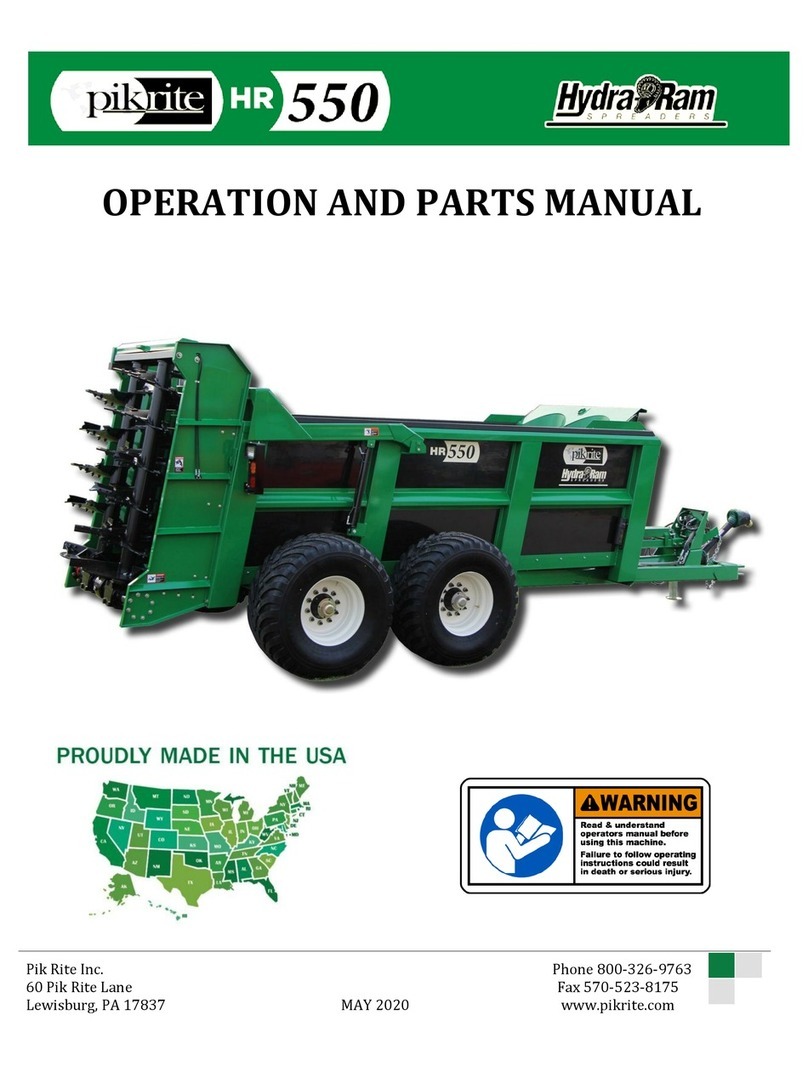
Pik Rite
Pik Rite Hydra-Ram HR550 Operation and parts manual
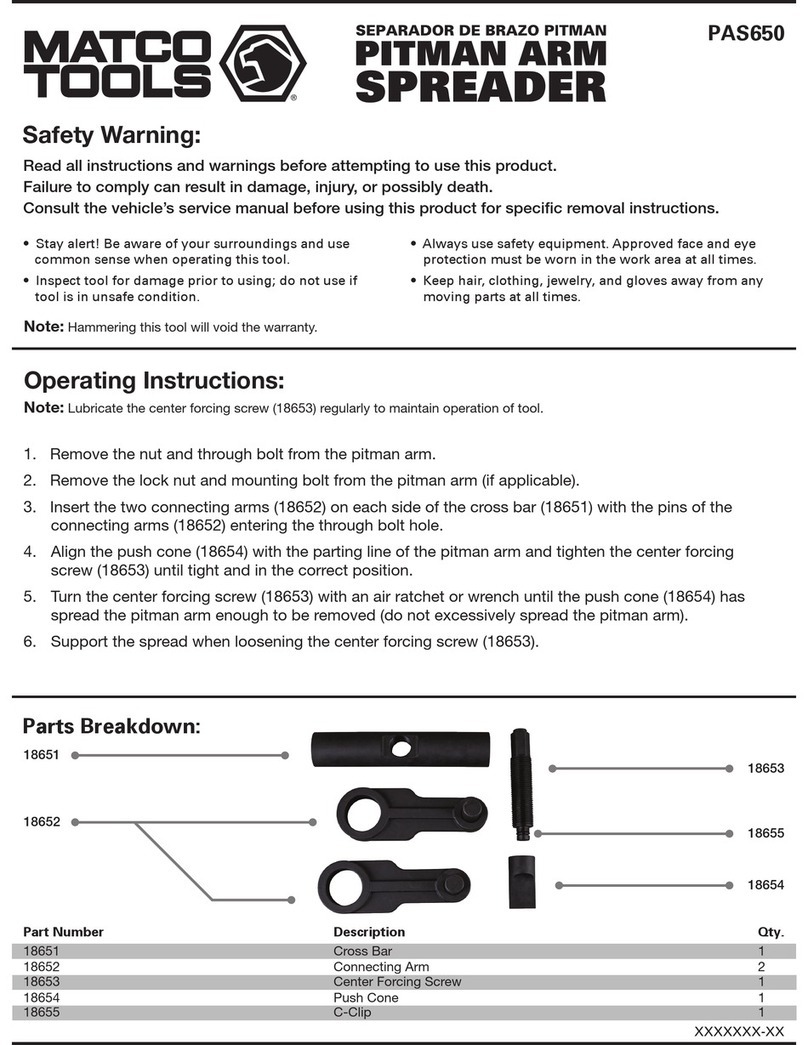
Matco Tools
Matco Tools PAS650 quick start guide
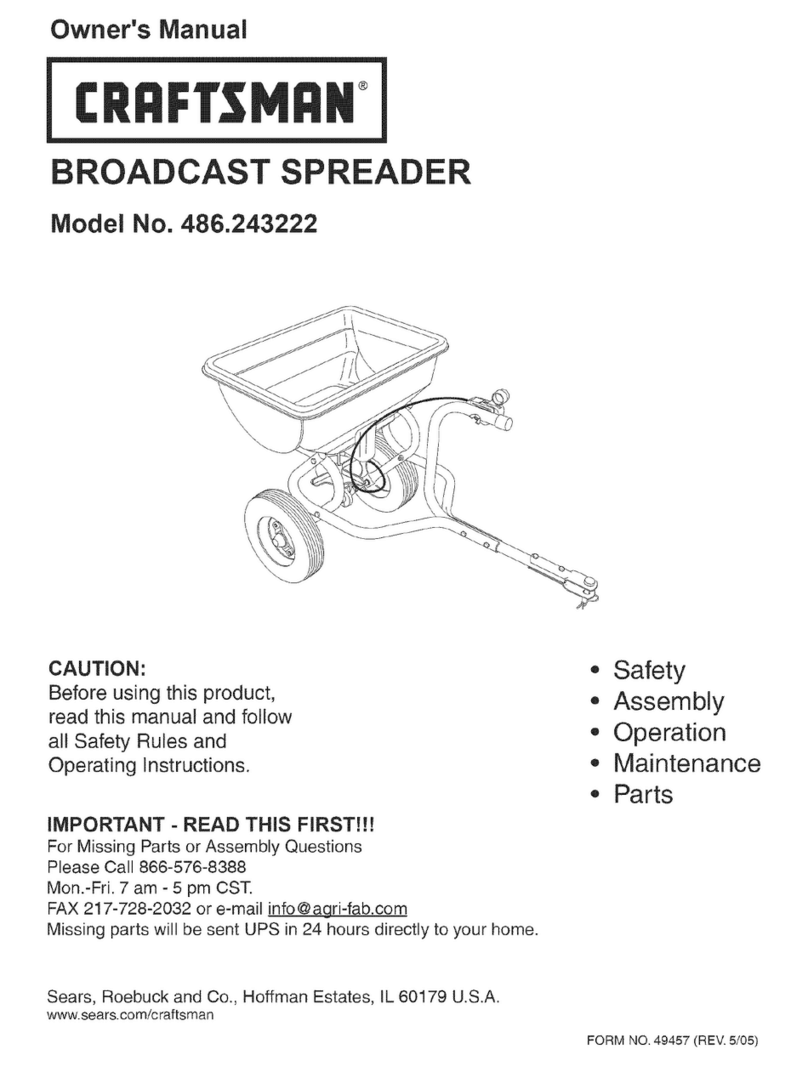
Craftsman
Craftsman 486.243222 owner's manual
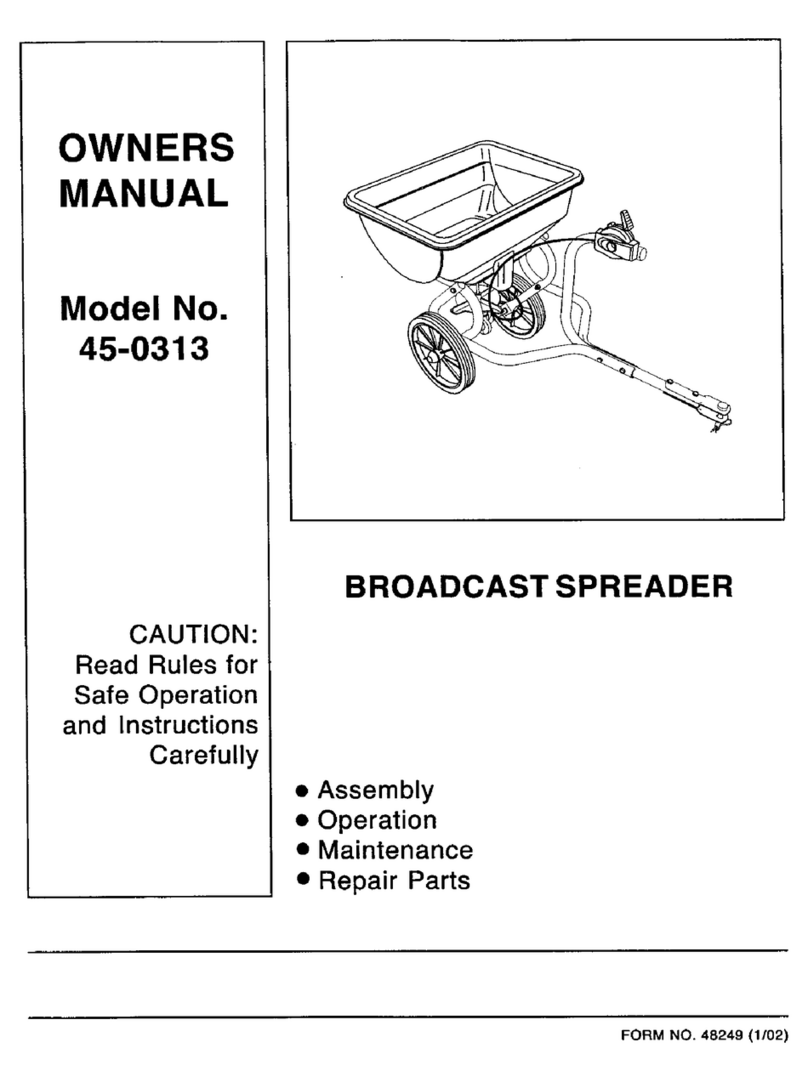
Agri-Fab
Agri-Fab 45-0313 owner's manual
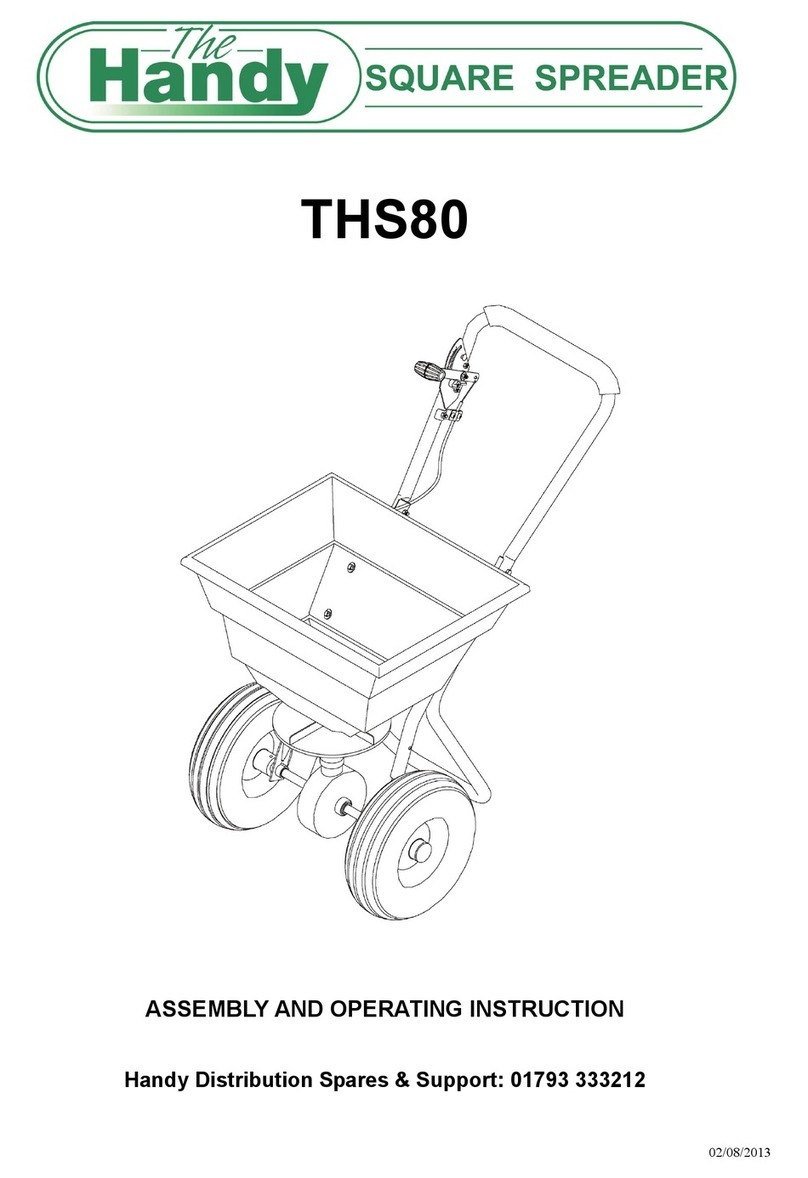
The Handy
The Handy THS80 Assembly and operating instructions

SnowEx
SnowEx SP-325 Owner's manual and installation instructions
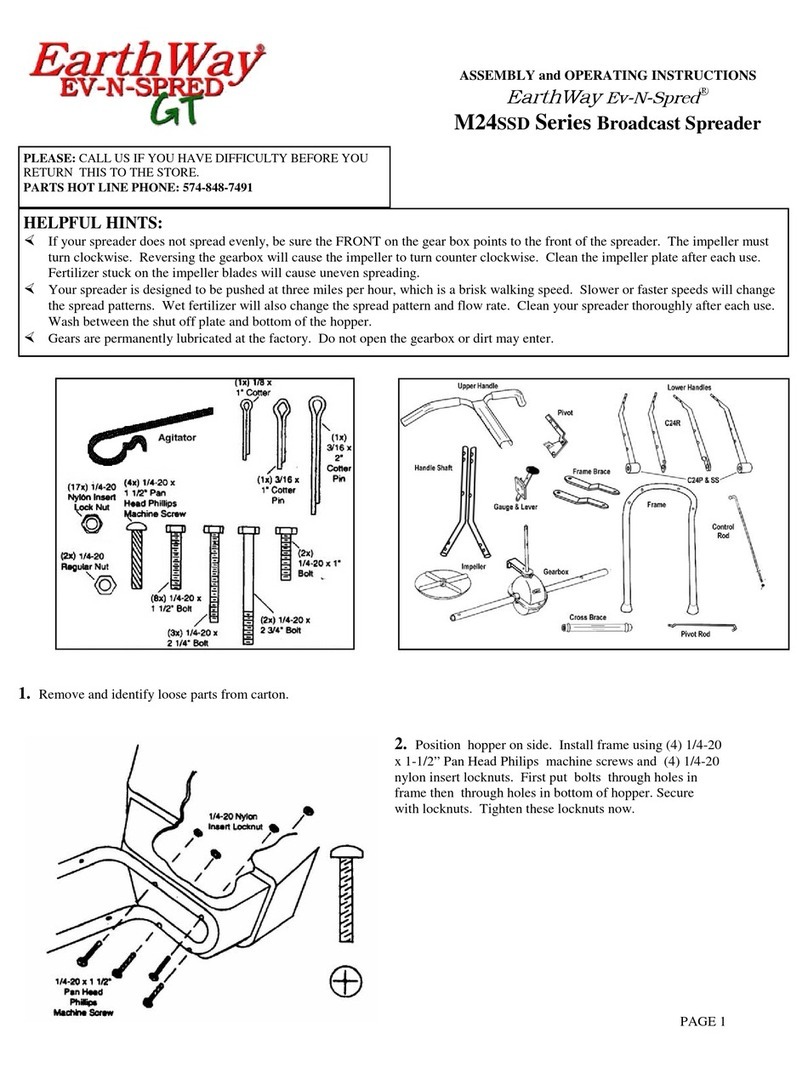
Earth Way
Earth Way Ev-N-Spred M24SSD Series Assembly and operating instructions
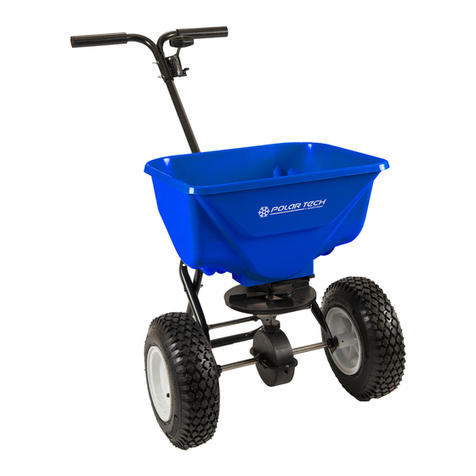
Earth Way
Earth Way Polar Tech 90365 Assembly instructions

Earth Way
Earth Way Polar Tech 90399 Assembly instructions

In-Ex
In-Ex 300 owner's manual

nosted
nosted IGLAND DS 600 owner's manual
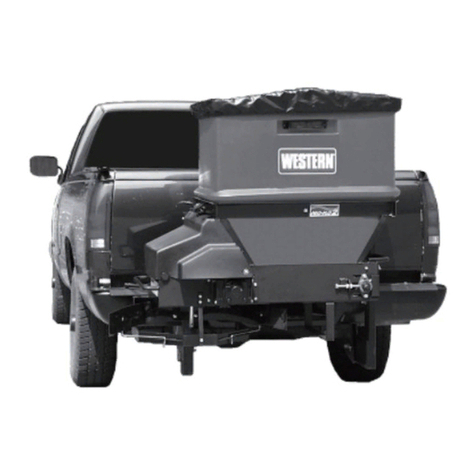
Western
Western PRO-FLO 2 owner's manual

